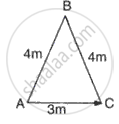Advertisements
Advertisements
प्रश्न
An ant travels a distance of 8 cm from P to Q and then moves a distance of 6 cm at right angles to PQ. Find its resultant displacement.
उत्तर १
We have to find the resultant displacement from the given diagram :

We have:
PQ = 8 cm and QR = 6 cm
Resultant displacement :
`PR = sqrt(PQ^2 + QR^2)`
= `sqrt(64+36)`
= `sqrt(100)`
= 10 cm
The direction of this displacement is from P to R. If θ is the angle made by PR with PQ then,'
`tan θ = "RQ"/"PQ"`
⇒ `tan θ = 36/64`
⇒ `θ = tan^-1 0.5625`
⇒ `θ = 29.36^circ`
This is the angle made by the resultant with PQ.
उत्तर २
To find the resultant displacement, we treat the movement of the ant as forming a right triangle, where:
- The distance from P to Q is 8 cm (one leg of the triangle).
- The distance moved at a right angle to PQ is 6 cm (the other leg of the triangle).
The resultant displacement is the hypotenuse of this right triangle, which can be calculated using the Pythagorean theorem:
Resultant displacement = `sqrt((8^2 + 6^2)`
Resultant displacement = `sqrt(64+36) = sqrt100 = 10 cm.`
The resultant displacement is 10 cm.
APPEARS IN
संबंधित प्रश्न
A farmer moves along the boundary of a square field of side 10 m in 40 s. What will be the magnitude of displacement of the farmer at the end of 2 minutes 20 seconds?
Can displacement be zero even if the distance is not zero? Give one example to explain your answer.
Calculate the distance and displacement in the following case:
The shortest distance between two places is ______.
Distinguish distance and displacement.
Distance is a ______ quantity.
The displacement is zero when the initial and final positions are ______.
Slope of a velocity-time graph gives
An object is dropped from rest at a height of 150 m and simultaneously another object is dropped from rest at a height of 100 m. What is the difference in their heights after 2s if both the objects drop with the same accelerations? How does the difference in heights vary with time?
A man leaves his house at 6.30 a.m. for a morning walk and returns back at 7.30 a.m. after covering 4 km. The Displacement covered by him is ______.
